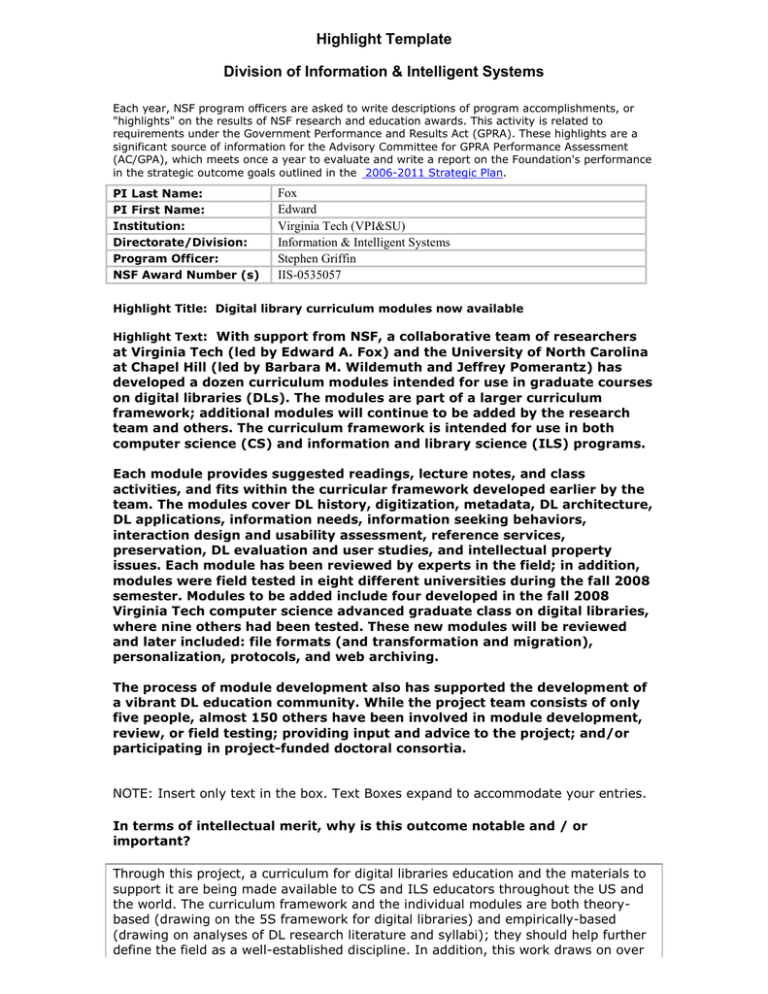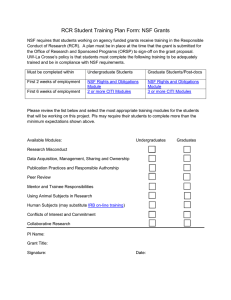Highlight Template Division of Information & Intelligent Systems
advertisement

Highlight Template Division of Information & Intelligent Systems Each year, NSF program officers are asked to write descriptions of program accomplishments, or "highlights" on the results of NSF research and education awards. This activity is related to requirements under the Government Performance and Results Act (GPRA). These highlights are a significant source of information for the Advisory Committee for GPRA Performance Assessment (AC/GPA), which meets once a year to evaluate and write a report on the Foundation's performance in the strategic outcome goals outlined in the 2006-2011 Strategic Plan. PI Last Name: PI First Name: Institution: Directorate/Division: Program Officer: NSF Award Number (s) Fox Edward Virginia Tech (VPI&SU) Information & Intelligent Systems Stephen Griffin IIS-0535057 Highlight Title: Digital library curriculum modules now available Highlight Text: With support from NSF, a collaborative team of researchers at Virginia Tech (led by Edward A. Fox) and the University of North Carolina at Chapel Hill (led by Barbara M. Wildemuth and Jeffrey Pomerantz) has developed a dozen curriculum modules intended for use in graduate courses on digital libraries (DLs). The modules are part of a larger curriculum framework; additional modules will continue to be added by the research team and others. The curriculum framework is intended for use in both computer science (CS) and information and library science (ILS) programs. Each module provides suggested readings, lecture notes, and class activities, and fits within the curricular framework developed earlier by the team. The modules cover DL history, digitization, metadata, DL architecture, DL applications, information needs, information seeking behaviors, interaction design and usability assessment, reference services, preservation, DL evaluation and user studies, and intellectual property issues. Each module has been reviewed by experts in the field; in addition, modules were field tested in eight different universities during the fall 2008 semester. Modules to be added include four developed in the fall 2008 Virginia Tech computer science advanced graduate class on digital libraries, where nine others had been tested. These new modules will be reviewed and later included: file formats (and transformation and migration), personalization, protocols, and web archiving. The process of module development also has supported the development of a vibrant DL education community. While the project team consists of only five people, almost 150 others have been involved in module development, review, or field testing; providing input and advice to the project; and/or participating in project-funded doctoral consortia. NOTE: Insert only text in the box. Text Boxes expand to accommodate your entries. In terms of intellectual merit, why is this outcome notable and / or important? Through this project, a curriculum for digital libraries education and the materials to support it are being made available to CS and ILS educators throughout the US and the world. The curriculum framework and the individual modules are both theorybased (drawing on the 5S framework for digital libraries) and empirically-based (drawing on analyses of DL research literature and syllabi); they should help further define the field as a well-established discipline. In addition, this work draws on over 50 years of the investigators’ teaching experience, as well as the contributions of almost 150 other teachers and many more students. In terms of broader impacts, why is this outcome notable and / or important? The curriculum framework and modules developed through this project will have a strong positive impact on the quality of DL education and training. The broad base of support for this work demonstrates that it will be disseminated widely, rather than just being implemented locally. In summary, it will improve the education of the next generation of digital librarians and DL developers, thus enhancing the quality of the DLs they create and manage. Does this highlight represent transformative or potentially transformative research? If so, please explain why. Yes x No No. Does this highlight represent Broadening Participation? If so, please explain why. Yes x No Yes, indirectly. Because many ILS programs are predominantly women, strengthening the DL curriculum in these programs is likely to bring more women into the field of digital libraries. Are there existing or potential societal benefits of this research? It is important for NSF to be able to provide examples of NSF-supported research that have societal benefits, including benefits to the U.S. economy. If so, please explain why. Yes No Yes. As the education of digital librarians and DL developers is improved, the quality of their work will have a positive impact on the users of the DLs they create and manage. These users may include a broad range of the US population, including scholars, cultural institutions and their target audiences, educators at all levels, and the general public. Select Primary (and Secondary) Strategic Outcome Goal Included below are two tables – titled Primary Strategic Outcome Goal and Secondary Strategic Outcome Goal. All NSF projects have “Primary” strategic outcome goals and they may also have “Secondary” strategic outcome goals. In the PRIMARY strategic outcome goal table please select one category (i.e., one column) that BEST DESCRIBES your project’s highlight. Within that column, please check one or more boxes that apply. If your project also has clear Secondary strategic outcome goals, select the appropriate column in the second table labeled “Secondary Strategic Outcome Goals and check as many boxes within that column that describe your project. So, for example, if your Primary Strategic Outcome Goal was Discovery, your Secondary Goal may be Learning. Primary Strategic Outcome Goal Decide whether your project’s Primary Strategic Outcome goals address Discovery, Learning or Research Infrastructure. For whichever of the three you select, please check one or more boxes within that column that best describe your project. Discovery Learning Foster research that will advance the frontiers of knowledge, emphasizing areas of greatest opportunity and potential benefit and establishing the nation as a global leader in fundamental and transformational science and engineering. Cultivate a world-class, broadly inclusive science and engineering workforce, and expand the scientific literacy of all citizens. Build the nation’s research capability through critical investments in advanced instrumentation, facilities, cyberinfrastructure and experimental tools. K-12 Education Teacher Training Undergraduate Education Graduate Education Postdoctoral Fellowships, including International Postdoctoral Fellowships International Research Experiences for Undergraduate & Graduate Students Public Understanding of Science Broadening Participation to Improve Workforce Development Promoting CyberLearning Strategies to Enhance STEM Education Professional and Career Development Please Note: If you are reporting an outcome of research conducted at an NSF-funded large facility and check the Major Multi-User Facilities category under Research Infrastructure for the PRIMARY goal, please also check the appropriate category under Discovery for the SECONDARY goal. Please Note: 1) If you are reporting an outcome from an EPSCoR Research Infrastructure Improvement grant, or a research grant co-funded with the EPSCoR Program, please check the EPSCoR box under DISCOVERY, as well as the box that represents the area of science, engineering, or education for the project. 2) If you are reporting an outcome of research conducted at an NSF-funded large facility and check a category under Discovery for the PRIMARY goal, please also check the Major Multi-User Facilities category under Research Infrastructure for the SECONDARY goal. Biological Sciences Computer & Information Science and Engineering Cyberinfrastructure (excluding Shared Cyberinfrastructure Tools) Engineering Research Small Business Innovation Research/Small Business Technology Geosciences: Earth, Atmosphere, and Ocean Sciences Geosciences: Earth, Atmosphere, and Ocean Sciences Social, Behavioral, & Economic Sciences Polar Sciences: Arctic and Antarctic Research CAREER: Faculty Early Career Program EPSCoR: Experimental Program to Stimulate Competitive Research International Collaborative Research Ed. Res. And Evaluation to Improve STEM Learning and Teaching Centers for Analysis & Synthesis Centers for Chemical Innovation Engineering Research Centers Materials Res. Science & Eng Centers/Networks Nanoscale Science & Eng Centers/Networks Science & Tech Centers Science of Learning Centers Research Infrastructure Academic Research Fleet ATLAS – A Toroidal Large Angle Spectrometer CMS – Compact Muon Solenoid Cornell Electron Storage Ring Gemini Observatory IRIS – Incorporated Research Institutes for Seismology Integrated Ocean Drilling Program Large Hadron Collider Laser Interferometer Gravitational Wave Observatory (LIGO) MREFC Projects National Astronomy and Ionosphere Center (NAIC) National Center for Atmospheric Research (NCAR) National High Magnetic Field Laboratory National Nanofabrication Infrastructure Network National Optical Astronomy Observatory (NOAO) National Radio Astronomy Observatory (NRAO) National Solar Observatory National Superconducting Cyclotron Laboratory Network for Earthquake Engineering Simulation (NEES) Polar Facilities & Logistics Major Research Instrumentation (MRI) Program Shared Cyberinfrastructure Tools Other Infrastructure and Research Resources Secondary Strategic Outcome Goal Complete this table only if your project has clear Secondary Outcome goals. So, for example, if your Primary Strategic Outcome Goal was Discovery, then your Secondary Strategic Outcome Goal can be either Learning or Research Infrastructure. Please check one or more boxes within that column that describe your project’s Secondary Strategic Outcome goals: Discovery Learning Foster research that will advance the frontiers of knowledge, emphasizing Cultivate a world-class, broadly inclusive science and engineering Research Infrastructure Build the nation’s research capability through critical investments in advanced areas of greatest opportunity and potential benefit and establishing the nation as a global leader in fundamental and transformational science and engineering. Please Note: 1) If you are reporting an outcome from an EPSCoR Research Infrastructure Improvement grant, or a research grant co-funded with the EPSCoR Program, please check the EPSCoR box under DISCOVERY, as well as the box that represents the area of science, engineering, or education for the project. 2) If you are reporting an outcome of research conducted at an NSF-funded large facility and check a category under Discovery for the PRIMARY goal, please also check the Major Multi-User Facilities category under Research Infrastructure for the SECONDARY goal. Biological Sciences Computer & Information Science and Engineering Cyberinfrastructure (excluding Shared Cyberinfrastructure Tools) Engineering Research Small Business Innovation Research/Small Business Technology Geosciences: Earth, Atmosphere, and Ocean Sciences Geosciences: Earth, Atmosphere, and Ocean Sciences Social, Behavioral, & Economic Sciences Polar Sciences: Arctic and Antarctic Research CAREER: Faculty Early Career Program EPSCoR: Experimental Program to Stimulate Competitive Research International Collaborative Research Ed. Res. And Evaluation to Improve STEM Learning and Teaching Centers for Analysis & Synthesis Centers for Chemical Innovation Engineering Research Centers Materials Res. Science & Eng Centers/Networks Nanoscale Science & Eng Centers/Networks Science & Tech Centers Science of Learning Centers workforce, and expand the scientific literacy of all citizens. instrumentation, facilities, cyber-infrastructure and experimental tools. K-12 Education Teacher Training Undergraduate Education Graduate Education Postdoctoral Fellowships, including International Postdoctoral Fellowships International Research Experiences for Undergraduate & Graduate Students Public Understanding of Science Broadening Participation to Improve Workforce Development Promoting CyberLearning Strategies to Enhance STEM Education Professional and Career Development Please Note: If you are reporting an outcome of research conducted at an NSF-funded large facility and check the Major Multi-User Facilities category under Research Infrastructure for the PRIMARY goal, please also check the appropriate category under Discovery for the SECONDARY goal. Academic Research Fleet ATLAS – A Toroidal Large Angle Spectrometer CMS – Compact Muon Solenoid Cornell Electron Storage Ring Gemini Observatory IRIS – Incorporated Research Institutes for Seismology Integrated Ocean Drilling Program Large Hadron Collider Laser Interferometer Gravitational Wave Observatory (LIGO) MREFC Projects National Astronomy and Ionosphere Center (NAIC) National Center for Atmospheric Research (NCAR) National High Magnetic Field Laboratory National Nanofabrication Infrastructure Network National Optical Astronomy Observatory (NOAO) National Radio Astronomy Observatory (NRAO) National Solar Observatory National Superconducting Cyclotron Laboratory Network for Earthquake Engineering Simulation (NEES) Polar Facilities & Logistics Major Research Instrumentation (MRI) Program Shared Cyberinfrastructure Tools Other Infrastructure and Research Resources NSF Investments (Existing and Proposed) -- select as many as apply Adaptive Systems Technology American Competitiveness Initiative (ACI) Climate Change Cyber-enabled Discovery and Innovation (CDI) Cyberinfrastructure Environment (including the importance of fresh water supplies) Homeland Security Human and Social Dynamics International Polar Year (IPY) National Nanotechnology Initiative (NNI) Networking and Information Technology Research Development (NITRD) Science of Science Policy Sensor Research Understanding Complex Biological Systems (including the interfaces of life, physical, and computational sciences) None Applicable Add Image Resolution should be 72 dpi or higher. Files must be GIFs or JPEGs. File names cannot contain spaces or punctuation other then dashes (-) or underscores (_). File names must be 25 characters or less. Images must be the size you want them to appear. Recommended maximum width and height are 240 pixels. Image: (Insert image below. If you have multiple images, please provide captions for each.) Image Caption: Digital libraries curriculum development logo Has NSF been granted permission to use this image? Yes No If yes, please enter the image credit: Digital libraries curriculum development logo Complete and Return NSF Form 1515 (Required):

